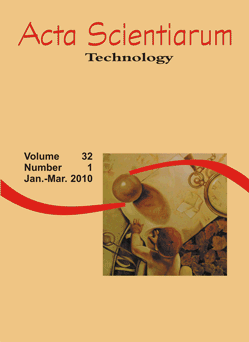<b>Influence of medium composition in the production of ethanol by <em>Zymomonas mobilis</em></b> - DOI: 10.4025/actascitechnol.v32i1.7454
DOI:
https://doi.org/10.4025/actascitechnol.v32i1.7454Keywords:
Zymomonas mobilis, ethanol, ethanol fermentation, factorial designAbstract
The production of ethanol using Zymomonas mobilis had been reported to be three to four times larger than with Saccharomyces cereviseae. The influence of pH, temperature and composition of the means of fermentation are parameters that can direct the metabolism for the production of ethanol. The objective of this study was to evaluate the production of ethanol by Zymomonas mobilis CCT 4494, by variations of the initial pH, temperature and concentrations KCl, K2SO4, MgSO4, CaCl2 and sucrose, by a factorial experimental design of type 27-2, according to the model proposed by Box et al. (1978). For this, the broth of sugar cane was used as sole carbon source, because it is cheap and easily accessible in the region of São José do Rio Preto, São Paulo State. According to the experimental design, the bacteria Zymomonas mobilis CCT 4494 has adapted in the fermentation mean containing high concentrations of sucrose, and supported the change of pH and temperature of fermentation. The highest amount of ethanol produced was 8.89 mg mL-1. This is not similar to the levels of secondary metabolites produced by Zymomonas mobilis CCT 4494.Downloads
Download data is not yet available.
Downloads
Published
2009-11-13
How to Cite
Ernandes, F. M. P. G., Boscolo, M., & Cruz, C. H. G. (2009). <b>Influence of medium composition in the production of ethanol by <em>Zymomonas mobilis</em></b> - DOI: 10.4025/actascitechnol.v32i1.7454. Acta Scientiarum. Technology, 32(1), 21–26. https://doi.org/10.4025/actascitechnol.v32i1.7454
Issue
Section
Biotechnology
License
DECLARATION OF ORIGINALITY AND COPYRIGHTS
I Declare that current article is original and has not been submitted for publication, in part or in whole, to any other national or international journal.
The copyrights belong exclusively to the authors. Published content is licensed under Creative Commons Attribution 4.0 (CC BY 4.0) guidelines, which allows sharing (copy and distribution of the material in any medium or format) and adaptation (remix, transform, and build upon the material) for any purpose, even commercially, under the terms of attribution.
Read this link for further information on how to use CC BY 4.0 properly.











8.png)




